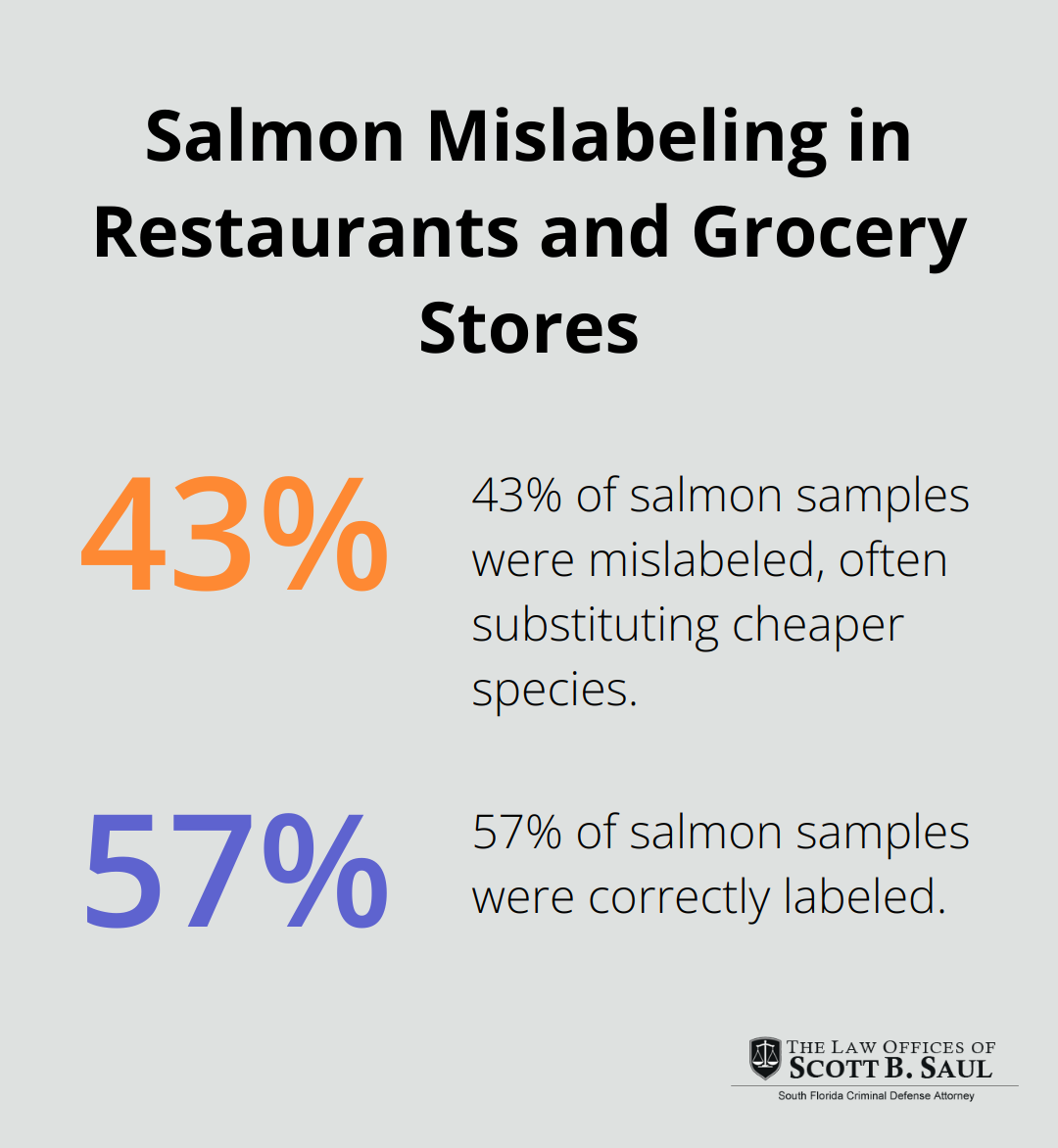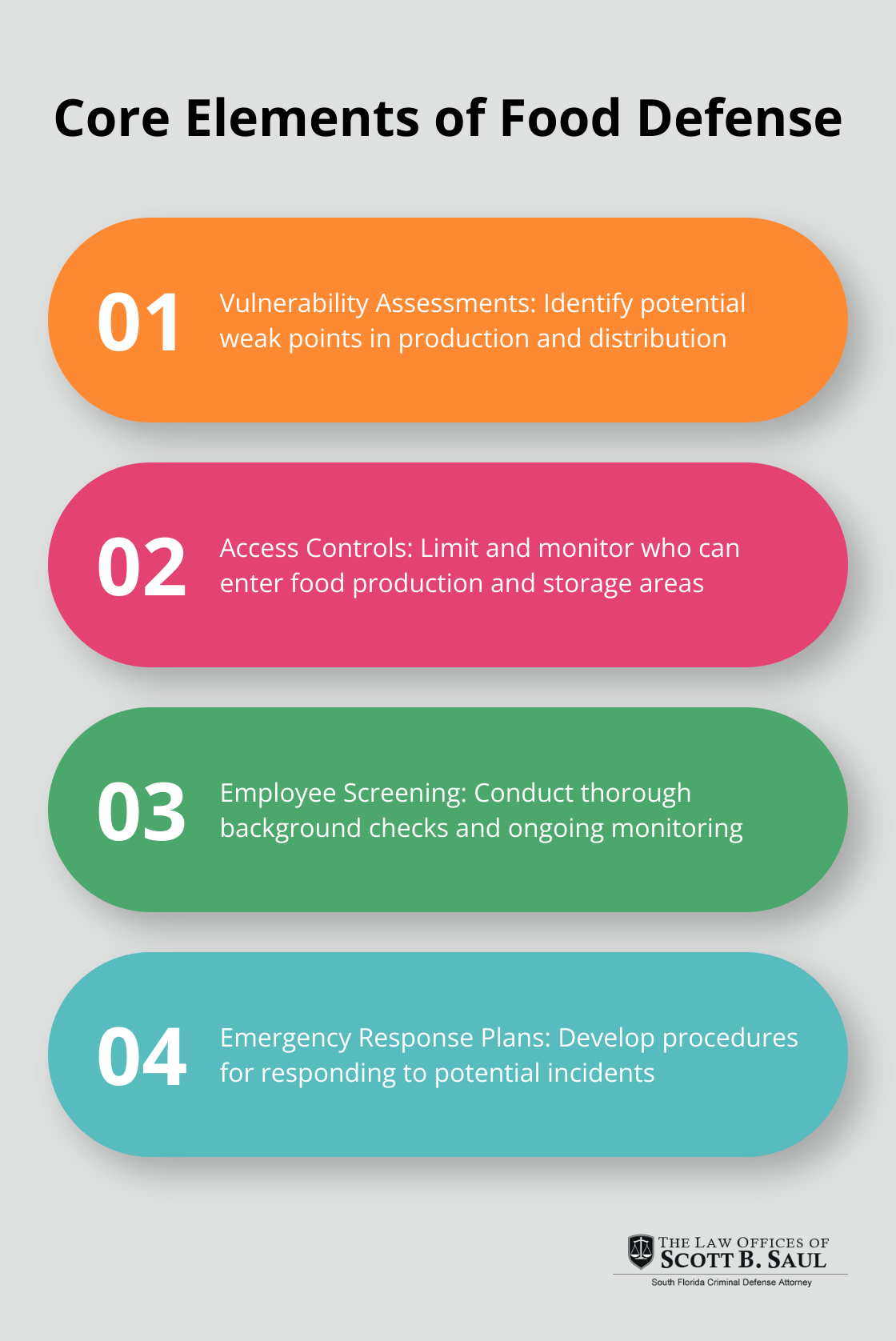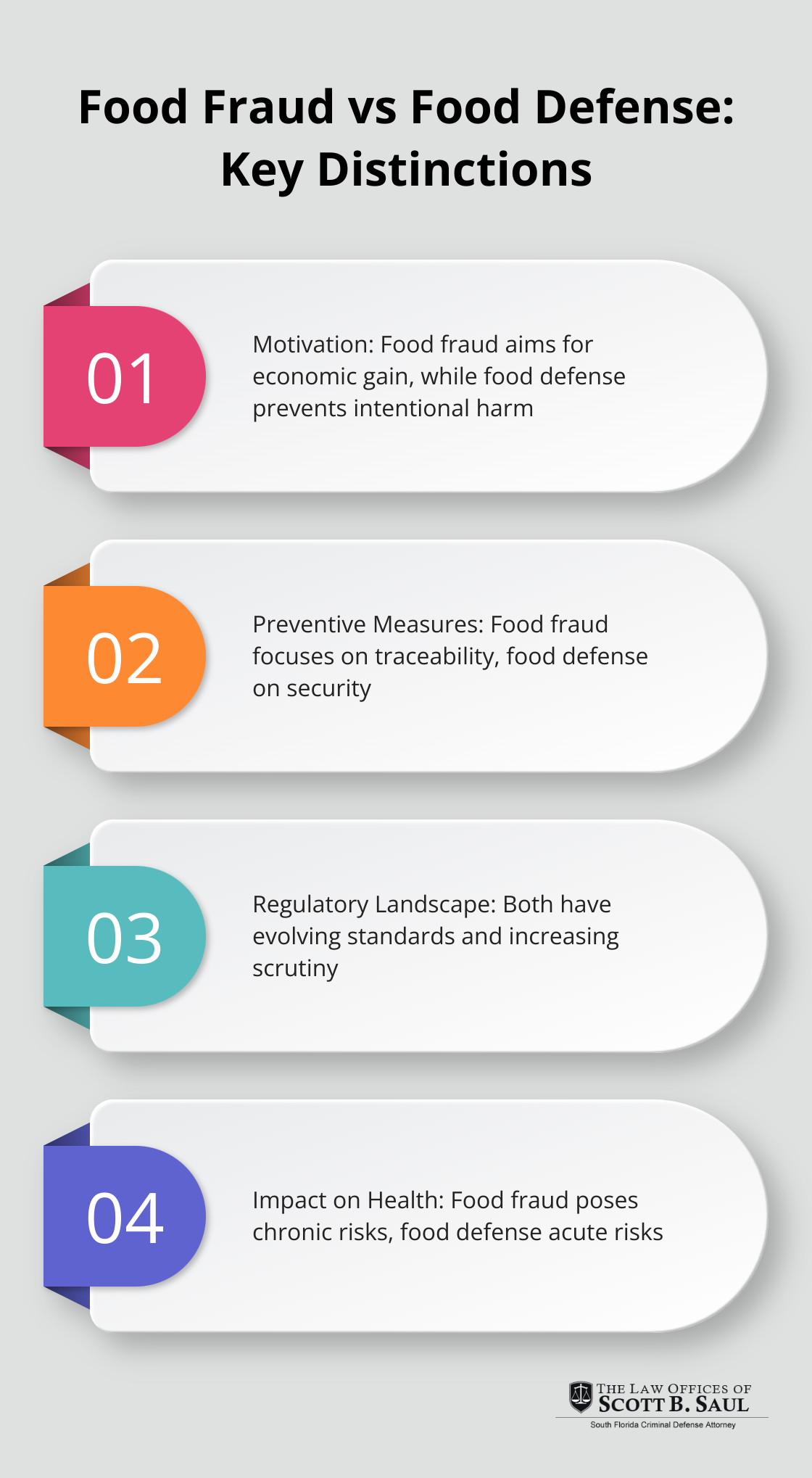Food Fraud vs Food Defense: What’s the Difference?
By : saulcrim | Category : Criminal Defense | Comments Off on Food Fraud vs Food Defense: What’s the Difference?
28th Apr 2025

At Law Offices of Scott B. Saul, we often encounter cases related to food safety and security. The distinction between food fraud and food defense is a critical aspect of maintaining a safe food supply chain.
Understanding the differences between these two concepts is essential for businesses and consumers alike. This blog post will explore food fraud vs food defense, their unique characteristics, and why both are vital in protecting our food systems.
What Is Food Fraud?
The Deceptive Practice Plaguing the Food Industry
Food fraud represents a significant challenge in the food industry. This deceptive practice involves the intentional misrepresentation of food products for economic gain. Fraudsters employ various methods, from diluting high-value ingredients to counterfeiting popular brands.
The Staggering Scope of Food Fraud
Outside estimates by experts have found that food fraud affects 1% of the global food industry at a cost of about $10-$15 billion a year. This figure highlights the pervasiveness of fraudulent activities within the food supply chain. Common targets for food fraud include olive oil, honey, and fish products. A study by Oceana revealed that 43 percent of salmon samples collected from restaurants and grocery stores were mislabeled, often substituting cheaper species for more expensive ones.

Common Types of Food Fraud
Adulteration: A Widespread Issue
Adulteration stands out as a prevalent form of food fraud. This practice involves the addition of inferior substances to food products to increase volume or enhance appearance. A notorious example (which shocked the world) was the addition of melamine to milk in China, resulting in severe health consequences for consumers.
Mislabeling: False Marketing Tactics
Mislabeling presents another significant problem in the food industry. Products are falsely marketed as organic or from a specific origin. The olive oil industry has proven particularly susceptible to this issue, with some estimates suggesting that up to 69% of extra virgin olive oil sold in the U.S. may not meet the legal standards for its label.
Economic Consequences of Food Fraud
The economic impact of food fraud extends far beyond direct financial losses. When fraud is uncovered, brand reputation can suffer irreparable damage. The 2013 horsemeat scandal in Europe serves as a prime example, leading to a significant drop in consumer trust and sales for affected companies.
Moreover, the costs associated with product recalls and legal actions can be substantial. Businesses found culpable in food fraud cases often face severe penalties, including hefty fines and potential criminal charges.
As we transition to our next topic, it’s important to note that while food fraud primarily focuses on economic deception, another critical aspect of food safety involves protecting against intentional harm. This brings us to the concept of food defense, which we will explore in detail in the following section.
How Does Food Defense Protect Our Food Supply?
The Core Elements of Food Defense
Food defense protects our food supply from intentional contamination or tampering aimed at causing harm. This critical aspect of food safety encompasses several key components:

- Vulnerability Assessments: Companies must identify potential weak points in their production and distribution processes where intentional contamination could occur.
- Access Controls: Strict measures limit and monitor who can enter food production and storage areas. These may include security personnel, ID badges, and biometric access systems.
- Employee Screening: Thorough background checks and ongoing monitoring of employees help mitigate insider threats.
- Emergency Response Plans: Well-defined procedures for responding to potential food defense incidents are essential for minimizing harm and containing threats quickly.
The FDA’s Role in Food Defense
The Food and Drug Administration (FDA) promotes food defense through its Food Safety Modernization Act (FSMA). Under the FSMA, food facilities must develop and implement food defense plans to address vulnerabilities in their operations.
Technology’s Role in Enhancing Food Defense
Advancements in technology have significantly bolstered food defense capabilities. For instance, some companies now use blockchain technology to create tamper-evident records of food products throughout the supply chain. This enhances traceability and makes it more difficult for malicious actors to introduce contaminants undetected.
Additionally, rapid testing technologies allow for quick identification of potential contaminants, enabling faster response times in the event of a food defense incident.
The Importance of Comprehensive Food Defense Strategies
Effective food defense requires a multi-faceted approach. Companies must:
- Conduct regular risk assessments
- Implement robust physical security measures
- Train employees on food defense protocols
- Stay updated on emerging threats and technologies
These strategies help create a resilient food supply chain that can withstand potential threats and maintain consumer trust.
As we explore the differences between food fraud and food defense, it becomes clear that both concepts play vital roles in ensuring the safety and integrity of our food supply. In the next section, we’ll compare these two areas in detail, highlighting their unique characteristics and the specific challenges they present to the food industry.
Food Fraud vs Food Defense: Distinct Challenges in Food Safety
Motivation: Economic Gain vs. Intentional Harm
Food fraud and food defense represent two critical areas of concern in the food industry, each with its own unique challenges and approaches. The primary distinction between these activities lies in their motivation.

Food fraud stems from economic gain. Perpetrators seek to maximize profits through deceptive practices. The substitution of cheaper fish species for more expensive ones exemplifies this profit-driven motive.
Food defense addresses threats motivated by the intent to cause harm. These threats include acts of terrorism, sabotage, or other malicious activities aimed at compromising public health or disrupting the food supply chain. The focus here is on the prevention of intentional contamination that could lead to widespread illness or fatalities.
Preventive Measures: Traceability vs. Security
The prevention of food fraud largely revolves around the enhancement of traceability and authentication methods. Companies invest in advanced testing technologies to verify the authenticity of ingredients and products. Advanced detection technologies coupled with chemometrics are being used to identify various types of adulterated foods.
Food defense emphasizes physical security measures and personnel management. This includes the implementation of strict access controls, thorough background checks on employees, and installation of surveillance systems. The FDA’s Food Safety Modernization Act (FSMA) requires food facilities to develop and implement food defense plans, highlighting the importance of these preventive measures.
Regulatory Landscape: Evolving Standards
The regulatory landscape for both food fraud and food defense continues to evolve. The Global Food Safety Initiative (GFSI) now requires food fraud vulnerability assessments as part of its certification schemes. This requirement has led to increased scrutiny of supply chains and the development of more robust fraud mitigation strategies.
For food defense, the FDA’s Intentional Adulteration Rule under FSMA mandates that food facilities assess vulnerabilities and implement risk-reducing strategies. This rule applies to both domestic and foreign companies that manufacture, process, pack, or hold food for consumption in the United States.
Impact on Public Health: Chronic vs. Acute Risks
The impact of food fraud on public health often manifests as chronic, long-term risks. While immediate health effects are possible, many fraudulent practices (such as dilution or substitution with lower-quality ingredients) may lead to nutritional deficiencies or exposure to harmful substances over time.
Food defense incidents typically pose acute, immediate risks to public health. A successful act of intentional contamination could result in a large-scale foodborne illness outbreak, potentially affecting thousands of consumers within a short period.
Understanding these distinctions proves essential for food industry professionals, regulators, and legal experts alike. The Law Offices of Scott B. Saul, with over 30 years of expertise in criminal defense, stands ready to assist clients facing legal challenges related to food safety violations, offering personalized attention and aggressive representation to protect their rights.
Final Thoughts
Food fraud and food defense present distinct challenges to the food industry. Companies must implement comprehensive safety programs that address both issues to maintain a safe and reliable food supply chain. The evolving regulatory landscape requires businesses to adapt their practices and protect themselves from legal repercussions.
At the Law Offices of Scott B. Saul, we understand the complexities of food safety regulations and their legal implications. Our experience in criminal defense, including cases involving tourists and foreign travelers, allows us to offer personalized attention and representation. Our background in federal and state prosecution provides valuable insights for developing effective defense strategies.
The food industry must continue to address the challenges of food fraud vs food defense proactively. Implementing robust safety measures and seeking appropriate legal guidance (when needed) will help businesses navigate these complex issues. This approach will contribute to a safer, more trustworthy food supply for all consumers.
Archives
- April 2025 (8)
- March 2025 (9)
- February 2025 (8)
- January 2025 (9)
- December 2024 (10)
- November 2024 (5)
- July 2024 (2)
- June 2024 (2)
- May 2024 (2)
- April 2024 (2)
- March 2024 (2)
- February 2024 (2)
- January 2024 (2)
- December 2023 (2)
- November 2023 (2)
- October 2023 (2)
- September 2023 (2)
- August 2023 (1)
- July 2023 (2)
- June 2023 (2)
- May 2023 (2)
- April 2023 (2)
- March 2023 (2)
- February 2023 (2)
- January 2023 (2)
- December 2022 (2)
- November 2022 (2)
- October 2022 (2)
- September 2022 (2)
- August 2022 (2)
- July 2022 (2)
- June 2022 (2)
- May 2022 (2)
- April 2022 (2)
- March 2022 (2)
- February 2022 (2)
- January 2022 (2)
- December 2021 (2)
- November 2021 (2)
- October 2021 (2)
- September 2021 (2)
- August 2021 (2)
- July 2021 (2)
- June 2021 (2)
- May 2021 (2)
- April 2021 (2)
- September 2020 (5)
- July 2020 (4)
- June 2020 (4)
- May 2020 (4)
- April 2020 (5)
- March 2020 (4)
- February 2020 (4)
- January 2020 (4)
- December 2019 (1)
- November 2019 (4)
- October 2019 (4)
- September 2019 (4)
- August 2019 (4)
- July 2019 (5)
- June 2019 (4)
- May 2019 (4)
- April 2019 (4)
- March 2019 (4)
- February 2019 (4)
- January 2019 (4)
- December 2018 (4)
- November 2018 (5)
- October 2018 (5)
- September 2018 (4)
- August 2018 (4)
- July 2018 (7)
- June 2018 (4)
- May 2018 (4)
- April 2018 (8)
- March 2018 (4)
- February 2018 (4)
- January 2018 (4)
- November 2017 (4)
- October 2017 (4)
- September 2017 (4)
- August 2017 (7)
- July 2017 (6)
- June 2017 (4)
- May 2017 (4)
- April 2017 (4)
- March 2017 (4)
- February 2017 (7)
- January 2017 (4)
- December 2016 (7)
- November 2016 (4)
- October 2016 (4)
- September 2016 (10)
- August 2016 (4)
- July 2016 (4)
- June 2016 (4)
- May 2016 (4)
- April 2016 (4)
- March 2016 (4)
- February 2016 (7)
- January 2016 (4)
- December 2015 (5)
- November 2015 (4)
- October 2015 (7)
- September 2015 (4)
- August 2015 (4)
- July 2015 (13)
- June 2015 (9)
- May 2015 (8)
- April 2015 (6)
- March 2015 (4)
- February 2015 (4)
- January 2015 (4)
- December 2014 (4)
- November 2014 (4)
- October 2014 (4)
- September 2014 (3)
Categories
- Adjudication (1)
- Bankruptcy (1)
- Burglary Crimes (3)
- calendar call (1)
- Car Accident (1)
- Criminal Defense (313)
- Cyber Crimes (7)
- DNA (1)
- Domestic Violence (9)
- Drug Crimes (5)
- DUI (12)
- Embezzlement (1)
- Environmental Crimes (4)
- Expungement Law (2)
- Federal Sentencing Law (3)
- Firearm (3)
- Forgery (4)
- General (82)
- Healthcare (3)
- Immigration (1)
- Indentity Theft (1)
- Insurance (5)
- judicial sounding (2)
- Juvenile Crimes (4)
- Manslaughter (4)
- Money Laundering (3)
- Organized Crime (1)
- Racketeering (1)
- Reckless Driving (3)
- RICO (3)
- Sealing and Expunging (2)
- Sex Offense (1)
- Shoplifting (1)
- Suspended Driver's License (1)
- Traffic (4)
- Trending Topics (1)
- White-collar Offenses (1)

